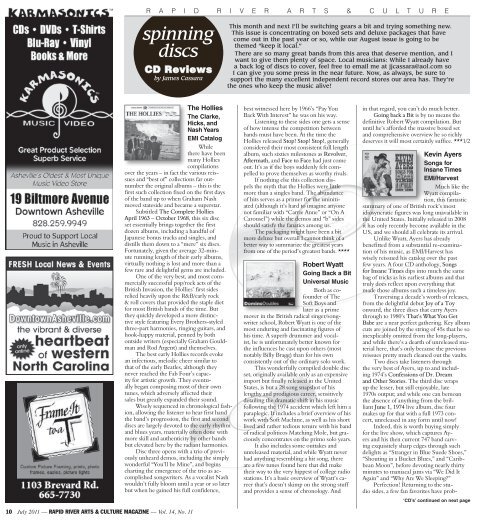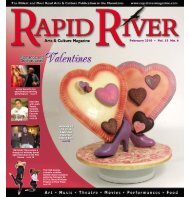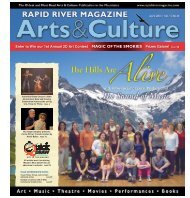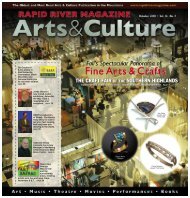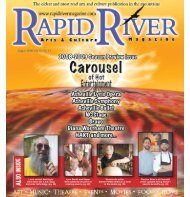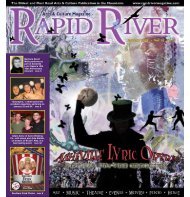craft fair of the southern highlands - Rapid River Magazine
craft fair of the southern highlands - Rapid River Magazine
craft fair of the southern highlands - Rapid River Magazine
You also want an ePaper? Increase the reach of your titles
YUMPU automatically turns print PDFs into web optimized ePapers that Google loves.
R A P I D R I V E R A R T S & C U L T U R E<br />
spinning<br />
discs<br />
CD Reviews<br />
by James Cassara<br />
This month and next I’ll be switching gears a bit and trying something new.<br />
This issue is concentrating on boxed sets and deluxe packages that have<br />
come out in <strong>the</strong> past year or so, while our August issue is going to be<br />
<strong>the</strong>med “keep it local.”<br />
There are so many great bands from this area that deserve mention, and I<br />
want to give <strong>the</strong>m plenty <strong>of</strong> space. Local musicians: While I already have<br />
a back log <strong>of</strong> discs to cover, feel free to email me at jjcassara@aol.com so<br />
I can give you some press in <strong>the</strong> near future. Now, as always, be sure to<br />
support <strong>the</strong> many excellent independent record stores our area has. They’re<br />
<strong>the</strong> ones who keep <strong>the</strong> music alive!<br />
The Hollies<br />
The Clarke,<br />
Hicks, and<br />
Nash Years<br />
EMI Catalog<br />
While<br />
<strong>the</strong>re have been<br />
many Hollies<br />
compilations<br />
over <strong>the</strong> years – in fact <strong>the</strong> various reissues<br />
and “best <strong>of</strong>” collections far outnumber<br />
<strong>the</strong> original albums – this is <strong>the</strong><br />
first such collection fixed on <strong>the</strong> first days<br />
<strong>of</strong> <strong>the</strong> band up to when Graham Nash<br />
moved stateside and became a superstar.<br />
Subtitled The Complete Hollies<br />
April 1963 – October 1968, this six disc<br />
set essentially brings toge<strong>the</strong>r <strong>the</strong> first<br />
dozen albums, including a handful <strong>of</strong><br />
Japanese bonus tracks and singles, and<br />
distills <strong>the</strong>m down to a “mere” six discs.<br />
Fortunately, given <strong>the</strong> average 32-minute<br />
running length <strong>of</strong> <strong>the</strong>ir early albums,<br />
virtually nothing is lost and more than a<br />
few rare and delightful gems are included.<br />
One <strong>of</strong> <strong>the</strong> very best, and most commercially<br />
successful pop/rock acts <strong>of</strong> <strong>the</strong><br />
British Invasion, <strong>the</strong> Hollies’ first sides<br />
relied heavily upon <strong>the</strong> R&B/early rock<br />
& roll covers that provided <strong>the</strong> staple diet<br />
for most British bands <strong>of</strong> <strong>the</strong> time. But<br />
<strong>the</strong>y quickly developed a more distinctive<br />
style featuring Every Bro<strong>the</strong>rs-styled<br />
three-part harmonies, ringing guitars, and<br />
hook-happy material, penned by both<br />
outside writers (especially Graham Gouldman<br />
and Rod Argent) and <strong>the</strong>mselves.<br />
The best early Hollies records evoke<br />
an infectious, melodic cheer similar to<br />
that <strong>of</strong> <strong>the</strong> early Beatles, although <strong>the</strong>y<br />
never reached <strong>the</strong> Fab Four’s capacity<br />
for artistic growth. They eventually<br />
began composing most <strong>of</strong> <strong>the</strong>ir own<br />
tunes, which adversely affected <strong>the</strong>ir<br />
sales but greatly expanded <strong>the</strong>ir sound.<br />
Wisely sequenced in chronological fashion,<br />
allowing <strong>the</strong> listener to hear first hand<br />
<strong>the</strong> band’s progression, <strong>the</strong> first and second<br />
discs are largely devoted to <strong>the</strong> early rhythm<br />
and blues years, materially <strong>of</strong>ten done with<br />
more skill and au<strong>the</strong>nticity by o<strong>the</strong>r bands<br />
but elevated here by <strong>the</strong> radiant harmonies.<br />
Disc three opens with a trio <strong>of</strong> previously<br />
unheard demos, including <strong>the</strong> simply<br />
wonderful “You’ll be Mine”, and begins<br />
charting <strong>the</strong> emergence <strong>of</strong> <strong>the</strong> trio as accomplished<br />
songwriters. As a vocalist Nash<br />
wouldn’t fully bloom until a year or so later<br />
but when he gained his full confidence,<br />
10 July 2011 — <strong>Rapid</strong> <strong>River</strong> ArtS & CULTURE <strong>Magazine</strong> — Vol. 14, No. 11<br />
best witnessed here by 1966’s “Pay You<br />
Back With Interest” he was on his way.<br />
Listening to <strong>the</strong>se sides one gets a sense<br />
<strong>of</strong> how intense <strong>the</strong> competition between<br />
bands must have been. At <strong>the</strong> time <strong>the</strong><br />
Hollies released Stop! Stop! Stop!, generally<br />
considered <strong>the</strong>ir most consistent full length<br />
album, such sixties milestones as Revolver,<br />
Aftermath, and Face to Face had just come<br />
out. It’s as if <strong>the</strong> boys suddenly felt compelled<br />
to prove <strong>the</strong>mselves as worthy rivals.<br />
If nothing else this collection dispels<br />
<strong>the</strong> myth that <strong>the</strong> Hollies were little<br />
more than a singles band. The abundance<br />
<strong>of</strong> hits serves as a primer for <strong>the</strong> uninitiated<br />
(although it’s hard to imagine anyone<br />
not familiar with “Carrie Anne” or “On A<br />
Carousel”) while <strong>the</strong> demos and “b” sides<br />
should satisfy <strong>the</strong> fanatics among us.<br />
The packaging might have been a bit<br />
more deluxe but overall I cannot think <strong>of</strong> a<br />
better way to summarize <strong>the</strong> greatest years<br />
from one <strong>of</strong> <strong>the</strong> period’s greatest bands. ****<br />
Robert Wyatt<br />
Going Back a Bit<br />
Universal Music<br />
Both as c<strong>of</strong>ounder<br />
<strong>of</strong> The<br />
S<strong>of</strong>t Boys and<br />
later as a prime<br />
mover in <strong>the</strong> British radical singer/songwriter<br />
school, Robert Wyatt is one <strong>of</strong> <strong>the</strong><br />
most enduring and fascinating figures <strong>of</strong><br />
his time. A superb drummer and vocalist,<br />
he is unfortunately better known for<br />
<strong>the</strong> influences he cast upon o<strong>the</strong>rs (most<br />
notably Billy Bragg) than for his own<br />
consistently out <strong>of</strong> <strong>the</strong> ordinary solo work.<br />
This wonderfully compiled double disc<br />
set, originally available only as an expensive<br />
import but finally released in <strong>the</strong> United<br />
States, is but a 28 song snapshot <strong>of</strong> his<br />
lengthy and prodigious career, sensitively<br />
detailing <strong>the</strong> dramatic shift in his music<br />
following <strong>the</strong> 1974 accident which left him a<br />
paraplegic. It includes a brief overview <strong>of</strong> his<br />
work with S<strong>of</strong>t Machine, as well as his short<br />
lived and ra<strong>the</strong>r tedious tenure with his band<br />
<strong>of</strong> radical politicos Matching Mole, but graciously<br />
concentrates on <strong>the</strong> primo solo years.<br />
It also includes some outtakes and<br />
unreleased material, and while Wyatt never<br />
had anything resembling a hit song, <strong>the</strong>re<br />
are a few tunes found here that did make<br />
<strong>the</strong>ir way to <strong>the</strong> very hippest <strong>of</strong> college radio<br />
stations. It’s a basic overview <strong>of</strong> Wyatt’s career<br />
that’s doesn’t skimp on <strong>the</strong> strong stuff<br />
and provides a sense <strong>of</strong> chronology. And<br />
in that regard, you can’t do much better.<br />
Going back a Bit is by no means <strong>the</strong><br />
definitive Robert Wyatt compilation. But<br />
until he’s afforded <strong>the</strong> massive boxed set<br />
and comprehensive overview he so richly<br />
deserves it will most certainly suffice. ***1/2<br />
Kevin Ayers<br />
Songs for<br />
Insane Times<br />
EMI/Harvest<br />
Much like <strong>the</strong><br />
Wyatt compilation,<br />
this fantastic<br />
summary <strong>of</strong> one <strong>of</strong> British rock’s most<br />
idiosyncratic figures was long unavailable in<br />
<strong>the</strong> United States. Initially released in 2008<br />
it has only recently become available in <strong>the</strong><br />
US, and we should all celebrate its arrival.<br />
Unlike Wyatt, Ayers has already<br />
benefitted from a substantial re-examination<br />
<strong>of</strong> his music, as EMI/Harvest has<br />
wisely reissued his catalog over <strong>the</strong> past<br />
few years. A four CD anthology, Songs<br />
for Insane Times dips into much <strong>the</strong> same<br />
bag <strong>of</strong> tricks as his earliest albums and that<br />
truly does reflect upon everything that<br />
made those albums such a timeless joy.<br />
Traversing a decade’s worth <strong>of</strong> releases,<br />
from <strong>the</strong> delightful debut Joy <strong>of</strong> a Toy<br />
onward, <strong>the</strong> three discs that carry Ayers<br />
through to 1980’s That’s What You Get<br />
Babe are a near perfect ga<strong>the</strong>ring. Key album<br />
cuts are joined by <strong>the</strong> string <strong>of</strong> 45s that he so<br />
inexplicably omitted from <strong>the</strong> long-players,<br />
and while <strong>the</strong>re’s a dearth <strong>of</strong> unreleased material<br />
here, that’s only because <strong>the</strong> previous<br />
reissues pretty much cleaned out <strong>the</strong> vaults.<br />
Two discs take listeners through<br />
<strong>the</strong> very best <strong>of</strong> Ayers, up to and including<br />
1974’s Confessions <strong>of</strong> Dr. Dream<br />
and O<strong>the</strong>r Stories. The third disc wraps<br />
up <strong>the</strong> lesser, but still enjoyable, late<br />
1970s output; and while one can bemoan<br />
<strong>the</strong> absence <strong>of</strong> anything from <strong>the</strong> brilliant<br />
June 1, 1974 live album, disc four<br />
makes up for that with a full 1973 concert,<br />
unreleased in any form until now!<br />
Indeed, this is worth buying simply<br />
for <strong>the</strong> live show, which captures Ayers<br />
and his <strong>the</strong>n current 747 band carving<br />
exquisitely sharp edges through such<br />
delights as “Stranger in Blue Suede Shoes,”<br />
“Shouting in a Bucket Blues,” and “Caribbean<br />
Moon”, before devoting nearly thirty<br />
minutes to maniacal jams via “We Did It<br />
Again” and “Why Are We Sleeping?”<br />
Perfection! Returning to <strong>the</strong> studio<br />
sides, a few fan favorites have prob-<br />
‘CD’s’ continued on next page


